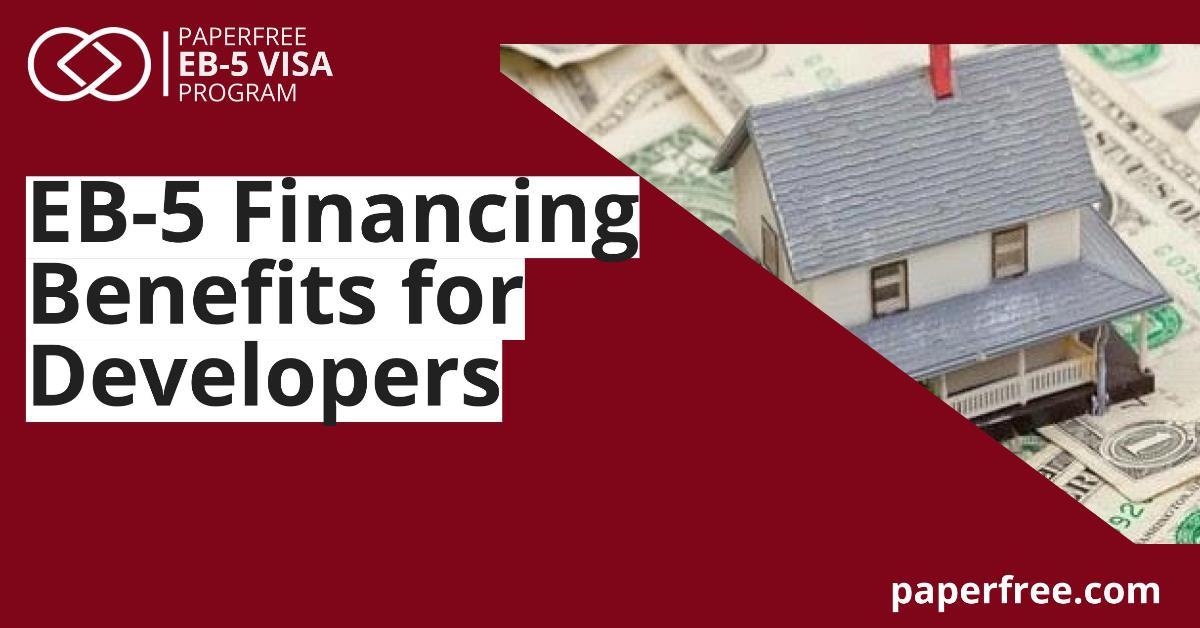EB-5 Financing | The key benefits for developers when raising capital for a new project.
Discover how EB-5 Financing offers perfect opportunities for developers to raise capital, supporting project development effectively. Explore the benefits and considerations of EB-5 financing for your investment endeavors.last updated Thursday, February 6, 2025
#Eb-5 financing #Eb5 financing
| | John Burson | Subscribe |

QUICK LINKS
AD
Get access to EB 5 Visa Investment Projects
Key Takeaways
- EB-5 Financing can provide non-recourse, term financing for the construction and development of new job-creating projects
- EB-5 Funding is sourced via foreign direct investment in the United States
- Funding is achieved by raising capital through the offering of securities by way of Private Placements
According to the latest update for 2023, there are 147 chartered centers for real estate EB5 projects, but only 11 in 2007. This interest in the program has potentially increased the credit crisis, forcing developers to get creative.
This is because most EB-5 capital—which can be structured as either debt or equity—is funneled through regional centers, matchmakers between foreign capital and local developers in need of funds.
Taher Kameli, principal of the Chicago-based regional center Chicagoland Foreign Investment Group in EB-5 says: “When the banks shut down during the recession, many people were looking for an inexpensive alternative financing. “The program is very attractive right now.”
Overview of EB5 Visa Funding
EB-5 financing offers non-recourse, term financing typically spanning five to six years, primarily directed towards new project construction and development. Developers stand to gain numerous advantages from this financing avenue.
As credit markets tightened in the wake of the financial crisis, more and more American businesses and developers turned toward EB-5 funds to raise the required capital for their projects.
For a detailed understanding of the EB-5 process, including key milestones and timelines, be sure to check out our comprehensive guide on the EB-5 Timeline: All You Need to Know.
EB-5 program benefits for developer
Flexibility and Limitations
Under EB-5 visa regulations, no predefined cap exists on the fundraising amount for a project, provided that each EB-5 investor contributes to creating a minimum of 10 new US jobs within the specified timeframe. This flexibility has drawn significant attention from various entities seeking funding.
Emergence of EB-5 Financing
In recent years, the sophistication of EB-5 financing has witnessed a remarkable surge, positioning itself as a credible alternative funding mechanism. Large real estate developers, private equity funds, and corporations increasingly embrace EB-5 financing for real estate projects.
Scope of EB-5 Projects
While minimal legal constraints exist on the types of projects eligible for EB-5 financing, most ventures tend to feature multi-layered financing and equity structures. These projects often encompass hotels, senior living facilities, multi-family apartment complexes, and mixed-use developments, incorporating retail and restaurant components.
Foreign Direct Investment and Legal Framework
EB-5 funding operates through foreign direct investment in the United States, facilitated and regulated by the EB-5 provisions within US immigration laws. This framework aims to facilitate lawful residency (Green Card status) for foreign investors.
Attractiveness and Complexities of EB5 Financing
EB-5 financing appeals particularly to sponsors and developers facing challenges securing funding from traditional lenders due to insufficient collateral, track record, or project nature. However, utilizing EB-5 financing entails navigating complexities inherent to securities financing, including upfront costs, timing implications, and securities considerations.
- Attractiveness
- Non-recourse, term financing (5-6 years) with no personal guarantees
- There is no cap on raised funds, only requiring ten new US jobs per investor.
- Applicable to diverse projects across various industries
- An attractive option for developers facing difficulties with traditional lenders
- Complexities
- Securities regulations mandate careful consideration of upfront costs, timing, and legal compliance.
- Investor's primary benefit is Green Card status, not solely financial returns.
The Key Benefits of Financing Projects through EB5 Program
Here's how developers can benefit:
- Lower Cost of Capital
EB-5 funds typically operate at lower interest rates than conventional loans or equity financing options.
Since EB-5 investors are primarily interested in obtaining U.S. residency rather than maximizing financial returns, they may accept lower returns on their investments. This can significantly reduce developers' overall cost of capital, making projects more financially feasible. - Longer-Term Capital
EB-5 financing often provides longer-term capital compared to traditional financing sources. While conventional loans may have shorter repayment periods, EB-5 funds are typically invested longer, aligning well with the extended timelines often associated with large-scale development projects. This can give developers greater flexibility in managing cash flow and completing projects on schedule.- Repayment terms range from five to seven years, allowing developers to defer repayment until project completion and revenue generation.
- Eases cash flow pressures during the construction phase.
- No Personal Guarantees
Unlike traditional lenders who may require personal guarantees from developers, EB5 funding typically does not necessitate such guarantees. Developers can mitigate the personal financial risk associated with the project, providing them with peace of mind and preserving personal assets. - Flexibility in Financing
- Developers can customize terms such as interest rates, repayment schedules, and collateral requirements to match project needs.
- Program Enhancements
- Suspension in 2021-2022 allowed for EB5 funding program improvements, increasing investor confidence and addressing fraud concerns.
- Introduction of priority project categories for rural, infrastructure, and TEA projects aimed at attracting investments from countries like China and India.
- Heightened Interest
- The creation of priority categories led to increased interest in the EB-5 program.
- The recent submission of 980 applications at the $800,000 investment threshold suggests a significant capital influx, potentially exceeding $784,000,000 in EB-5 capital raised in the last six months.
- Advantageous in Volatile Market
- The surge in EB-5 capital is beneficial for real estate developers seeking funding amidst market volatility and rising interest rates.
Overall, EB-5 financing presents a unique opportunity for developers to access significant capital for diverse projects. However, understanding its intricacies and investor motivations with the help of EB5 fiancing stats is crucial for successful implementation.
Regarding exit strategies, developers should consider the following:
A developer must identify one or more exit strategies for any project seeking funding.
- Project Completion and Sale
One common exit strategy for developers funded through EB-5 financing is to complete the project successfully and sell the developed properties or assets at a profit. This allows developers to repay EB-5 investors and generate returns for themselves. - Refinancing
Developers may choose to refinance the project once it is completed and stabilized. By refinancing with traditional loans at more favorable terms or attracting equity investors, developers can repay EB-5 investors while retaining ownership and potentially unlocking additional value in the project. - Redeployment of Funds
Developers must also plan to redeploy EB-5 funds in case the project is completed before investors' conditional residency status is lifted. Identifying alternative investment opportunities that meet EB-5 program requirements is crucial to ensure compliance and maintain investors' immigration eligibility.
EB5 Statistics
EB5 Financing Statistics 2022
| Metric | Data | Source |
|---|---|---|
| Overall Investment | ||
| Investment volume | $5.5 billion | EB5 Investors Magazine |
| Number of investors | ~8,200 | The AICE Companies |
| Visa Issuance | ||
| Total EB-5 visas issued | 10,855 | EB5 BRICS |
| Adjustment of status | 4,003 | EB5 BRICS |
| Consular processing | 6,852 | EB5 BRICS |
| Popular Investment Types | ||
| Regional Center | Majority share | EB5 Investors Magazine |
| Direct Investment | Growing popularity | EB5 Investors Magazine |
| Minimum Investment | ||
| TEA projects | $800,000 | N/A |
| Non-TEA projects | $1,050,000 | N/A |
| Project Approval Rate | ~80% | Invest in EB-5 |
| Investment Capital Raised | $8.7 billion | The AICE Companies |
| EB-5 Visa Wait Times | Varied by nationality |
EB5 Financing Statistics, 2023
| Metric |
Data |
Source |
| Investment Volume (Q4 2023) |
2,735 new investors |
IMI Daily |
| Visa Issuance (as of September 2023) |
8,700 total visas issued, 150 in September |
IIUSA |
| Popular Investment Types |
1. Regional Center 2. Direct Investment |
EB5 Investments |
| Minimum Investment Amount |
$800,000 (TEA), $1,050,000 (non-TEA) |
USCIS |
| Project Approval Rate |
637 approvals in Q3 2023 |
EB5 Visa Investments |
| Investment Capital Raised (Q1 2023) |
At least $444.8 million |
EB5 BRICS |
| EB-5 Visa Wait Times |
Varies by nationality (China: advancing, India: significant progress) |
IIUSA |
Most EB-5 investments are made into real estate projects, ranging from commercial properties to residential developments.
Real estate developers often use EB-5 financing to fund a portion of their project costs, with the remaining capital typically raised through traditional financing methods such as bank loans, private equity, and mezzanine financing.
EB-5 Financing for Multifamily Real Estate Developments
While there aren’t millions of investors lining up, the program benefits a Chinese citizen who wishes a Green Card to live in the US.
EB-5 Financing for Commercial Real Estate Developments
EB-5 financing can be an effective way for commercial real estate developers to finance multifamily and commercial properties throughout the U.S. However, pending changes could challenge the effectiveness of this program.
This commercial real estate financing method involves an EB-5 visa issued to a non-US citizen in exchange for investment funds. It’s also known as the Immigrant Investor Program, created by Congress in 1980 to stimulate the economy by providing funds to commercial properties and creating more construction, trade, and administrative jobs.
| Feature |
Information |
| Investment Requirement |
$900,000 (minimum) |
| Job Creation Requirement |
10+ workers directly in the U.S. |
| Previous Minimum |
$500,000 |
| Top Investor Nation (2023) |
China (>80% of visas) |
| Example Projects Funded |
Andaz Hotel (Palm Springs), Hudson Yards (Manhattan) |
| Potential Impact Without EB-5 |
Projects might not have been planned |
| Suspension Due to Demand |
2 months in 2022 |
| Current Investor Interest |
Growing |
| Annual Visa Limit |
9,940 |
| Program Issues |
Regularly changing policies |
| Process Duration |
Lengthy |
| Repayment Terms |
Up to 4 years |
| Investor & Project Owner Hesitation |
Low |
There are some speed bumps. China’s crackdown on investment corruption could potentially decrease the number of qualifying EB-5 investors. There has also been the question of whether funds over $900,000 may be required, disqualifying more investors. Stateside, developers are becoming frustrated with the program's delays, and many have withdrawn their applications. Loan terms are also becoming riskier for foreign investors.
Traditional banks still can’t get high enough in the capital stack for development loans for commercial projects. Thus, EB5 funds remain an attractive investment source of investment capital.
Outlook for EB-5 Financing in 2024
The outlook for EB5 financing in 2024 is cautiously optimistic, with several factors suggesting potential growth but also requiring careful consideration. Here's a breakdown of the critical aspects:
- Potential increased activity
Interest and investment volume could rise due to program improvements and priority categories. - Focus on project selection.
Attracting investors will depend on offering well-structured, economically sound projects within priority categories. - Increased Investor Interest
Recent data shows higher application volumes and rising investment numbers, particularly in priority project categories. - Program Improvements
The 2022 reform addressed integrity concerns and potentially made the program more attractive to a broader range of investors. - Favorable Loan Terms
EB5 loan financing offers lower interest rates and longer repayment terms than traditional options. - Demand for Capital
Developers may find the EB-5 Program a valuable funding source in a volatile market with tightening traditional financing avenues.
How to Use EB-5 Financing Successfully
To successfully use EB5 Financing in real estate projects, individuals must first know what EB-5 investment options offer. Understanding these options allows them to choose the approach that aligns best with their investment goals, risk tolerance, and desired level of involvement in the project.
EB-5 investment options are offered
For financing EB5 investment, EB-5 Program offers two investment pathways for foreign nationals.
- Individual developers/investors can invest independently, handling all aspects of the investment process.
- Developers can pool their funds and invest through an EB-5 regional center, which must maintain licensure and comply with USCIS standards.
As of June 1, 2015, USCIS had approved over 600 plus regional centers responsible for processing investors and ensuring compliance. While individual investors must navigate the investment process alone, those using a regional center benefit from pooled funds and professional management.
To qualify for a regional center, business owners must directly apply to USCIS, offering investment opportunities in new commercial enterprises, often involving securities offerings. Once approved, investors can apply for conditional lawful permanent residency.
Developers across the country effectively utilize the EB-5 program to secure substantial capital for various projects, catering to groups of varying sizes, from small investor pools to larger groups exceeding 100 participants.
EB-5 financing utilized in various projects
- Large-scale commercial developments
- Casinos
- Hotels
- Assisted-living facilities
- Manufacturing plants
- Mixed-use complex
Noteworthy completed projects funded through EB-5 range from $1.5 million to $600 million.
However, despite its benefits, the EB-5 program has drawbacks. Deals financed through EB-5 can experience prolonged closure periods, often lasting 12 to 18 months, necessitating interim EB5 bridge financing.
Additionally, navigating EB-5 financing entails complexities and demands substantial professional expertise, potentially elevating transaction costs. Moreover, funds may be held in escrow until the petition is approved, possibly needing to be returned if the petition is denied.
Instead of fast-paced endeavors, EB-5 financing shines in long-term projects like the Sahara Hotel revamp or the $600 million Hudson Yards complex.
While bridge loans can offer a workaround, the program's limitations favor investors' patience for high-impact results.
How can investors successfully use EB-5 financing?
For the successful placement of EB-5 financing, investors need to ensure that the targeted project possesses specific essential characteristics. These include selecting a developer with a stake in the project, sufficient resources, a proven track record in development, and having secured capital to cover the entire project cost. Additionally, undertaking the following due diligence steps is advised when pursuing EB-5 financing.
EB-5 Financing: Checklist and Key Points
EB5 Project Checklist
| Checklist | Description | |
| [ ] | Choose right developer | Stake in project Sufficient resources Proven track record |
| [ ] | Fully funded project | Secured capital for the entire project cost |
EB5 Processing
| Checklist | Description | |
| [ ] | Secure subscription agreement & funds | Investors commit & send funds. |
| [ ] | File I-526 petition | Initiate green card applications for investors. |
| [ ] | Petition removal | Apply for removal of green card conditions upon project completion. |
EB5 Financing Due Diligence
| Checklist | Description | |
| [ ] | Confirm job creation | Ensure the project creates the required number of jobs. |
| [ ] | Speak to marketing agents. | Consult relevant agents in the target country (if applicable) |
| [ ] | Contact regional center | Establish regional contacts for guidance. |
| [ ] | Prepare legal documents | PPM, subscription agreement, operating agreement/partnership agreement. |
| [ ] | Determine financing source | Secure other needed financing |
| [ ] | Translate documents | Make project information accessible to foreign investors |
EB5 Financing Key Points
| Point | Description |
| Flexibility | Fits in various capital structures |
| Interest rates | Lower than standard loans (2-7% vs. 10-12%) |
| Term | 5-year financing term |
| Structure | Typically, mezzanine debt or preferred equity (many prefer mezzanine) |
| Capital benefits | Replaces expensive bridge capital or investor equity |
| Drawdown limitations | Requires approval (up to 14 months) |
| Uses | Funding soft costs, construction, working capital, replacing bridge capital |
| Individual investment | Possible, but requires direct project management |
| Cost considerations | Factor in fees associated with EB-5 investment |
Frequently Asked Questions
How does EB5 financing work?
EB-5 financing is an investment-based immigration program that allows foreign investors to obtain a green card by investing in a U.S. business. Administered by the U.S. Citizenship and Immigration Services (USCIS), applicants must invest at least $900,000 in a U.S. business that creates or retains at least ten full-time jobs for American workers. The investment must be at risk, and investors must demonstrate the lawful source of their funds and how the investment will benefit the U.S. economy. Upon approval, investors and their families can obtain green cards.
What are the benefits of EB-5 financing for multifamily real estate developments?
EB-5 financing offers significant advantages for multifamily real estate developments. It provides access to capital from foreign investors, supports project development, offers lower interest rates compared to conventional financing, and provides a flexible repayment structure. Additionally, EB-5 financing can offer access to tax incentives, like the deferral of capital gains taxes upon property sale.
What are the requirements for EB-5 financing for multifamily real estate developments?
To qualify for EB-5 financing, a multifamily real estate development project must create 10 full-time jobs for U.S. citizens or permanent residents and be located in a Targeted Employment Area (TEA) or a rural region. Investors must contribute a minimum of $900,000 to the project.
What are the risks associated with EB-5 financing for multifamily real estate developments?
EB-5 financing for multifamily real estate developments carries several risks. The primary risk is the potential failure to meet the job creation requirements stipulated by the EB-5 program, which could result in investors losing their investment and not obtaining their green card. Additionally, investors face typical real estate investment risks, such as construction delays, budget overruns, and market volatility.
What are the costs associated with EB-5 financing for multifamily real estate developments?
The costs associated with EB-5 financing for multifamily real estate developments include a $10,000 application deposit, lender fees ranging from $4,500 to $13,000 (covering due diligence and third-party reports), and a rate lock deposit of 1-2% (refundable upon closing). Additionally, replacement reserves of $250 per unit are typically required.
How to use eb-5 capital in commercial real estate?
The EB-5 program allows investors to use capital for commercial real estate projects that create jobs, making it an attractive option for developers. EB-5 financing for real estate can fund large-scale developments such as hotels, office spaces, or mixed-use properties. By utilizing EB-5 program real estate investment, investors can meet job creation requirements while supporting high-impact projects. The EB-5 visa real estate option provides a pathway to permanent residency while promoting economic growth through real estate ventures.
Final Thoughts
Getting EB-5 funding starts with understanding the program requirements and aligning your project with them. EB-5 for developers seeking capital is an excellent option, especially in the commercial real estate sector. To utilize EB 5 program real estate opportunities, developers need to ensure their projects meet the job creation criteria and investment thresholds outlined in the EB-5 program real estate investment guidelines.
EB5 financing for real estate works by attracting capital from foreign investors seeking U.S. residency through the EB-5 visa. This financing is typically structured as an EB5 investment loan or EB-5 loan, offering flexible, long-term, non-recourse funding options. Developers asking, "Can I get loan for EB5 visa projects?" can consult EB-5 consulting for property developers to understand the process, from structuring investments to complying with program requirements.
With EB 5 visa real estate funding, developers can unlock significant financial advantages. EB-5 for developers not only provides a pathway to secure capital but also supports large-scale projects that drive job creation and economic growth. By leveraging EB 5 financing, developers can bring transformative real estate projects to life while contributing to U.S. economic development.
Free Consultation
Similar Pages
- EB-5 Investment Repayment| Exit Strategies and Financial Returns

- EB-5 Funding 3.0 for Investors | EB5 Visa

- EB-5 Visa Real Estate Investment Path: Paperfree 2025-2026 Insights

- Can an EB-5 Investment Be a Gift? | Gifted Funds for EB-5 Visas

- US EB-5 Real Estate: Benefits to foreign investors for a permanent residence in America

- EB 5 Visa consultants in China. EB-5 Visa for Chinese Investors | Paperfree.com

- Latest USCIS Guidelines on Noncompliance with EB-5 Regional Center Program

- When are EB-5 funds required to be deployed?

Popular
Benefits of the EB-5 Visa Program | Guide
Search within Paperfree.com
